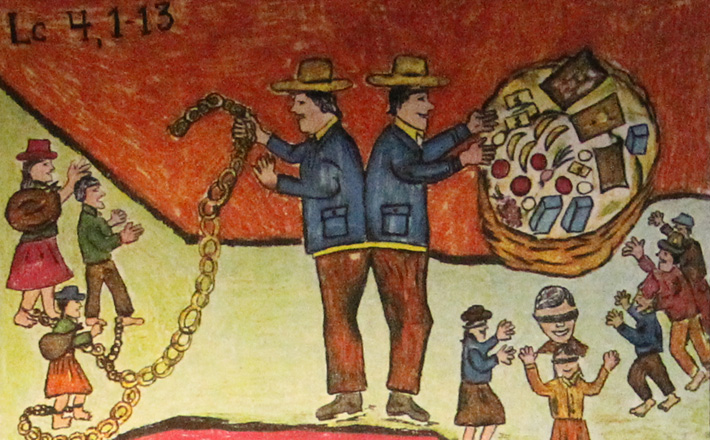Commentary on Luke 4:1-13
John Milton’s epic poem Paradise Lost, a retelling of the fall of Adam and Eve and hence humanity from God’s original created perfection, is fairly well known.
Much less well known, unfortunately, is the sequel, Paradise Regained. Especially striking about the latter poem is its subject — not the birth, crucifixion, or resurrection of Jesus, but his temptation, the subject of today’s Gospel text. Milton rightly saw that in resisting the devil’s temptations Jesus initiated the possibility for humanity to regain the paradise lost in the Eden fall.
Jesus and Adam
Luke himself invites us to make such a comparison with the Genesis fall by the way he has set the story. First, he has put the genealogy of Jesus immediately before it. Since Luke’s genealogy traces Jesus’ lineage all the way back to Adam, the reference to Adam immediately precedes the temptation account. Moreover, Adam is identified in the genealogy as the son of God (3:38), rather obviously inviting comparison to Jesus. The temptation story, then, fleshes out the comparison — and the contrast!
Second, the temptation story is followed by Jesus’ announcement of the nature of his ministry in the Nazareth synagogue. The temptation story, as we will see, has as a primary point to show what Jesus is not going to do in his ministry. The Nazareth synagogue sermon then gives us the positive: Jesus will bring “good news to the poor… release to the captives… recovery of sight to the blind… the oppressed go free… the year of the Lord’s favor” (4:18-19). Mary was told by the angel that Jesus was coming to establish his kingdom (1:33); thus what Jesus describes in the synagogue is the nature of his kingdom, the kingdom of God.
His kingdom, of course, is not about the political rule of Israel but rather the reclamation by God of the entire fallen world. So whereas the succumbing to temptation by Adam and Eve resulted in the loss of life in God’s presence, Jesus’ resistance of temptation was the beginning of the restoration of life in God’s presence. Romans 5:12-21 famously makes the Adam-Christ comparison explicit, while here in Luke it is mainly implicit.
The First Temptation: Serving Oneself
Given this comparison, it is perhaps significant that the first temptation (verses 3-4) relates to eating, just as the temptation in the garden of Eden did. More broadly, the temptation is for Jesus to use his authority as the Son of God to meet his personal needs and desires. While this was no doubt a temptation for Jesus throughout his ministry, it is especially during his crucifixion that this would come to the fore again, as he is tempted by the onlookers to save himself from the cross (Luke 23:35-39). Just as there the temptation is made in a situation of tremendous personal suffering, so too here the temptation to eat comes in a time of severe hunger, with Jesus having fasted for forty days. As we have heard him announce in 4:18-19, Jesus’ ministry is always focused on others, never on himself.
The Second Temptation: Power
The second temptation (verses 5-8) is a direct appeal to the human desire for power. Jesus is offered the authority and glory of all the kingdoms of the world. For Jesus this was a temptation to embrace what many would have expected of him as the Messiah: political and military might and rule. That Jesus rejects this is a clear sign that his messiahship, his kingdom, is of a different nature than the common expectations. The contrast with Jesus’ announced mission in 4:18-19 is again clear: Jesus’ mission is about saving others, not about asserting worldly power.
The Third Temptation: A Cross-Avoiding Spectacle
The third temptation (verses 9-12), jumping from the pinnacle of the temple, is the most difficult to interpret. On the surface the devil’s idea is merely an awe-inducing spectacle. In the ancient world such would likely have been interpreted as the trick of a magician. Legends developed later in the church about the apostles facing down such devil-inspired magicians (e.g. a flying Simon the Mage in the Acts of Peter).
So in part this temptation is that of another alternative path for Jesus’ power, leading to fame and riches rather than to service and the cross. But we are likely supposed to see more here, too. The temptation, after all, occurs on the Jerusalem temple. Are we meant to see a foreshadowing and a parody of the crucifixion? As discussed above, on the cross Jesus is tempted to save himself from death — are the onlookers there playing the role of the devil?
The Forty Days of Lent
Jesus is said to be tempted over a forty day period (verse 2). This is likely meant to echo the forty days Moses spent fasting while writing the covenant for the people of Israel (Exodus 34:27-28), and it also is reminiscent of the forty years the Israelites spent in the desert experiencing their own temptations. It is, of course, no coincidence that Lent is a forty day period. Thus how can the account of Jesus’ temptation illuminate our own forty day experience?
To answer this question, note that the common thread in the devil’s three temptations is an alternative mission and destiny to the cross and Jesus’ pronouncement in 4:18-19. Since as Christians we are called to continue the Spirit-led proclamation and enactment of God’s kingdom (note the importance of the Spirit in 4:1, 14, 18), we are also tempted to abandon the task God has given us for ways of self-fulfillment, power, and spectacle. Unlike Jesus, we will doubtlessly fail at times. Lent is the time for confessing our failures and redirecting our steps to the way of Jesus. And through the power of the Spirit, we, too, can resist the temptations of the devil.


February 17, 2013